Food and Beverage Operations Management: A Restaurant Report Analysis
VerifiedAdded on 2023/01/12
|7
|1648
|55
Report
AI Summary
This report delves into the critical aspects of food and beverage operations management, offering a comprehensive analysis of various systems and methods. It begins by identifying different food and beverage production systems, including conventional, convenience, centralized, and call order production, providing real-world examples to illustrate each. The report then explores diverse service methods in restaurants, such as table service, English service, French service, and silver service, highlighting the characteristics and implications of each. Furthermore, the report analyzes food production control, emphasizing the importance of HACCP principles to ensure food safety and quality. It also covers volume forecasting techniques to predict sales and manage inventory efficiently, along with the significance of standard recipes in maintaining consistency and controlling costs. The report uses a case study of Lisa, who is setting up her grandfather's restaurant, to illustrate the practical application of these concepts, and the report concludes with a summarization of the key takeaways and their importance in the food and beverage industry.
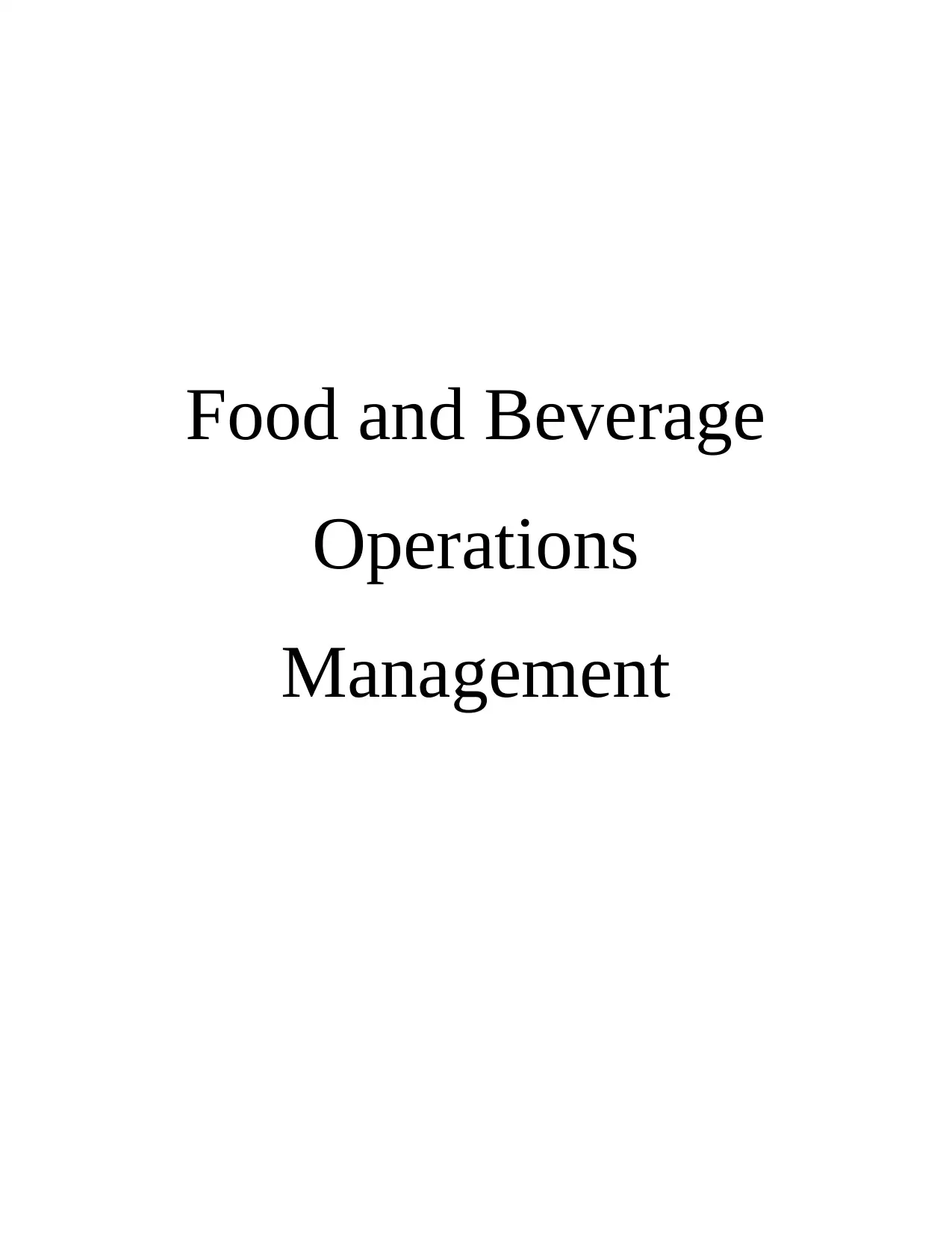
Food and Beverage
Operations
Management
Operations
Management
Paraphrase This Document
Need a fresh take? Get an instant paraphrase of this document with our AI Paraphraser
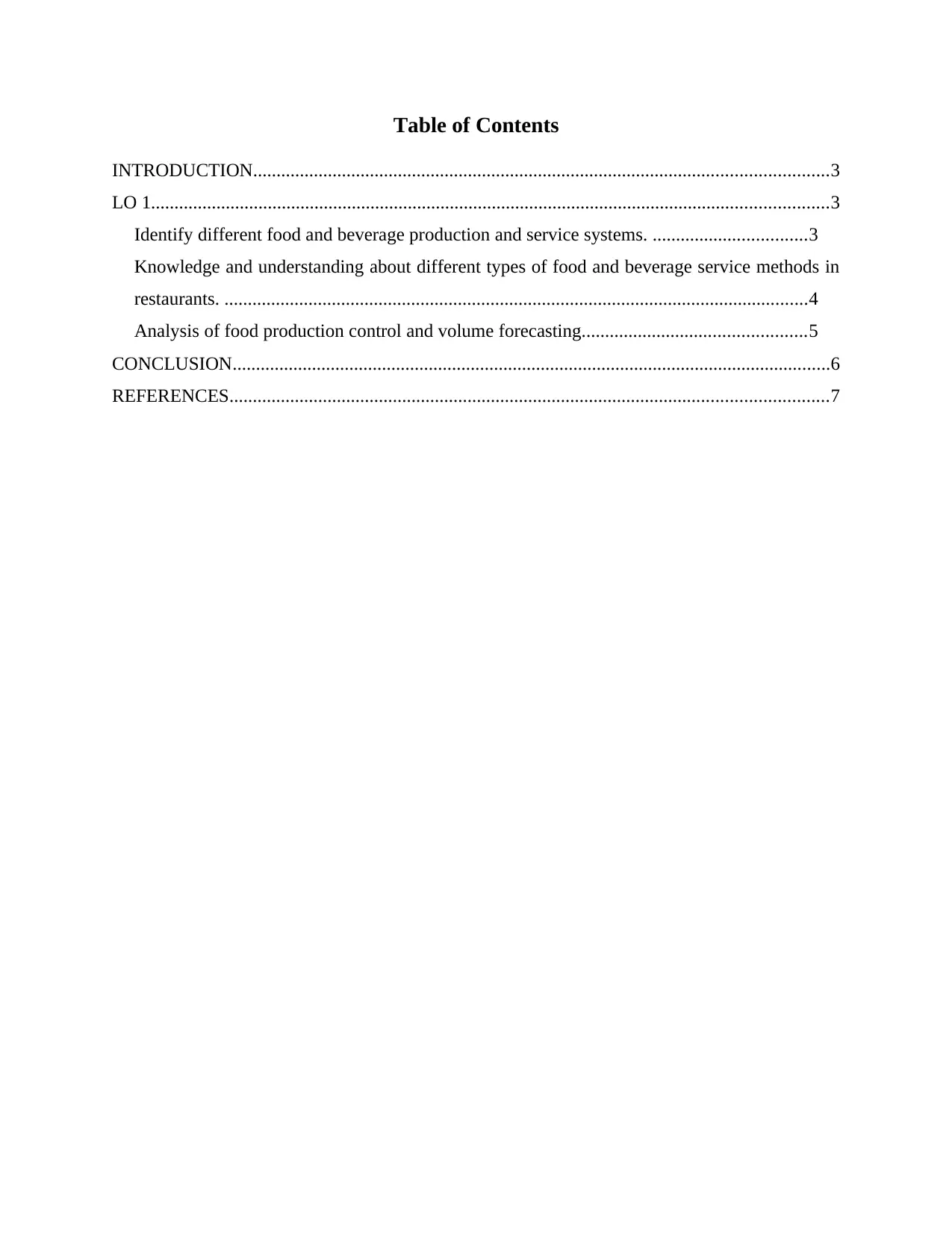
Table of Contents
INTRODUCTION...........................................................................................................................3
LO 1.................................................................................................................................................3
Identify different food and beverage production and service systems. .................................3
Knowledge and understanding about different types of food and beverage service methods in
restaurants. .............................................................................................................................4
Analysis of food production control and volume forecasting................................................5
CONCLUSION................................................................................................................................6
REFERENCES................................................................................................................................7
INTRODUCTION...........................................................................................................................3
LO 1.................................................................................................................................................3
Identify different food and beverage production and service systems. .................................3
Knowledge and understanding about different types of food and beverage service methods in
restaurants. .............................................................................................................................4
Analysis of food production control and volume forecasting................................................5
CONCLUSION................................................................................................................................6
REFERENCES................................................................................................................................7
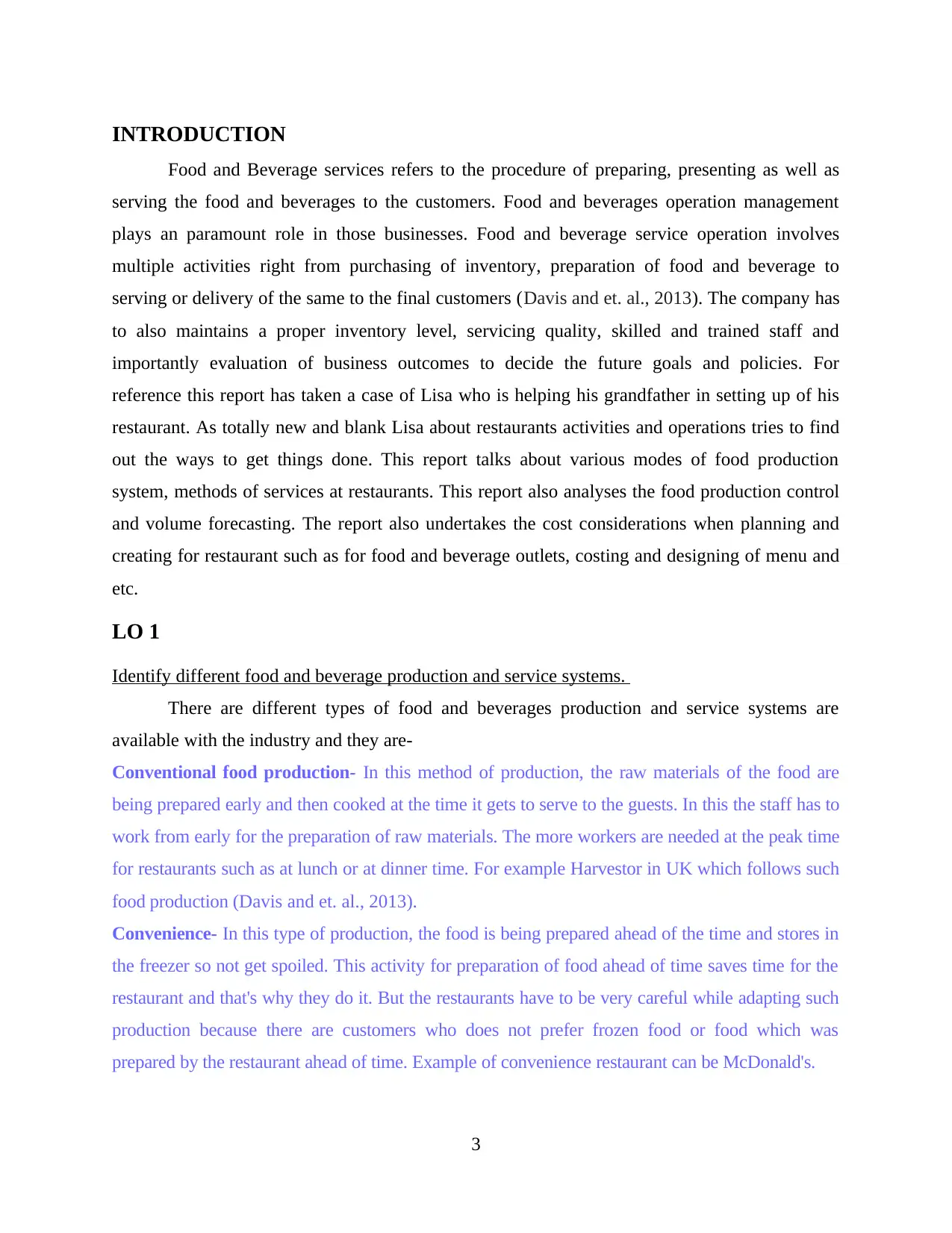
INTRODUCTION
Food and Beverage services refers to the procedure of preparing, presenting as well as
serving the food and beverages to the customers. Food and beverages operation management
plays an paramount role in those businesses. Food and beverage service operation involves
multiple activities right from purchasing of inventory, preparation of food and beverage to
serving or delivery of the same to the final customers (Davis and et. al., 2013). The company has
to also maintains a proper inventory level, servicing quality, skilled and trained staff and
importantly evaluation of business outcomes to decide the future goals and policies. For
reference this report has taken a case of Lisa who is helping his grandfather in setting up of his
restaurant. As totally new and blank Lisa about restaurants activities and operations tries to find
out the ways to get things done. This report talks about various modes of food production
system, methods of services at restaurants. This report also analyses the food production control
and volume forecasting. The report also undertakes the cost considerations when planning and
creating for restaurant such as for food and beverage outlets, costing and designing of menu and
etc.
LO 1
Identify different food and beverage production and service systems.
There are different types of food and beverages production and service systems are
available with the industry and they are-
Conventional food production- In this method of production, the raw materials of the food are
being prepared early and then cooked at the time it gets to serve to the guests. In this the staff has to
work from early for the preparation of raw materials. The more workers are needed at the peak time
for restaurants such as at lunch or at dinner time. For example Harvestor in UK which follows such
food production (Davis and et. al., 2013).
Convenience- In this type of production, the food is being prepared ahead of the time and stores in
the freezer so not get spoiled. This activity for preparation of food ahead of time saves time for the
restaurant and that's why they do it. But the restaurants have to be very careful while adapting such
production because there are customers who does not prefer frozen food or food which was
prepared by the restaurant ahead of time. Example of convenience restaurant can be McDonald's.
3
Food and Beverage services refers to the procedure of preparing, presenting as well as
serving the food and beverages to the customers. Food and beverages operation management
plays an paramount role in those businesses. Food and beverage service operation involves
multiple activities right from purchasing of inventory, preparation of food and beverage to
serving or delivery of the same to the final customers (Davis and et. al., 2013). The company has
to also maintains a proper inventory level, servicing quality, skilled and trained staff and
importantly evaluation of business outcomes to decide the future goals and policies. For
reference this report has taken a case of Lisa who is helping his grandfather in setting up of his
restaurant. As totally new and blank Lisa about restaurants activities and operations tries to find
out the ways to get things done. This report talks about various modes of food production
system, methods of services at restaurants. This report also analyses the food production control
and volume forecasting. The report also undertakes the cost considerations when planning and
creating for restaurant such as for food and beverage outlets, costing and designing of menu and
etc.
LO 1
Identify different food and beverage production and service systems.
There are different types of food and beverages production and service systems are
available with the industry and they are-
Conventional food production- In this method of production, the raw materials of the food are
being prepared early and then cooked at the time it gets to serve to the guests. In this the staff has to
work from early for the preparation of raw materials. The more workers are needed at the peak time
for restaurants such as at lunch or at dinner time. For example Harvestor in UK which follows such
food production (Davis and et. al., 2013).
Convenience- In this type of production, the food is being prepared ahead of the time and stores in
the freezer so not get spoiled. This activity for preparation of food ahead of time saves time for the
restaurant and that's why they do it. But the restaurants have to be very careful while adapting such
production because there are customers who does not prefer frozen food or food which was
prepared by the restaurant ahead of time. Example of convenience restaurant can be McDonald's.
3
⊘ This is a preview!⊘
Do you want full access?
Subscribe today to unlock all pages.

Trusted by 1+ million students worldwide
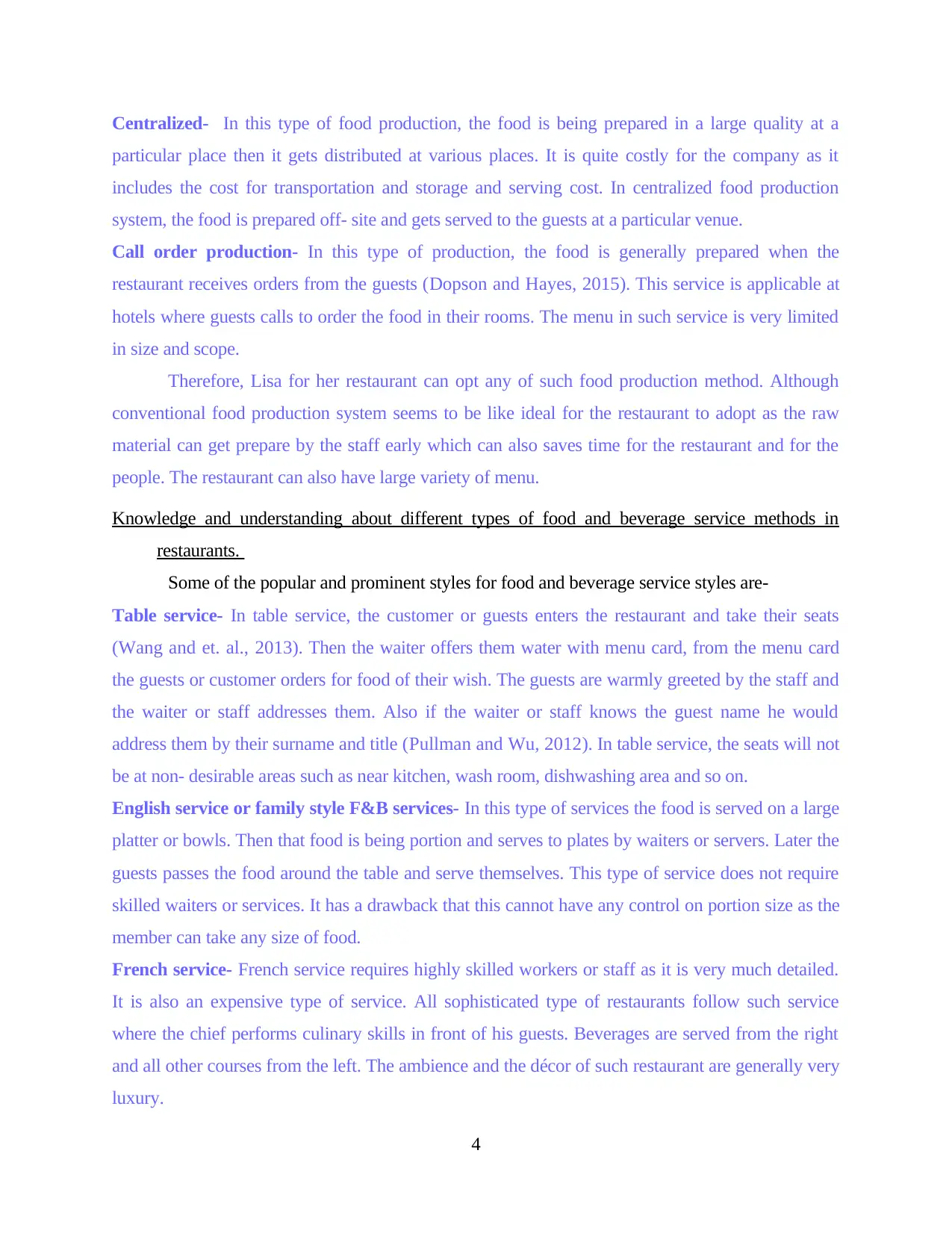
Centralized- In this type of food production, the food is being prepared in a large quality at a
particular place then it gets distributed at various places. It is quite costly for the company as it
includes the cost for transportation and storage and serving cost. In centralized food production
system, the food is prepared off- site and gets served to the guests at a particular venue.
Call order production- In this type of production, the food is generally prepared when the
restaurant receives orders from the guests (Dopson and Hayes, 2015). This service is applicable at
hotels where guests calls to order the food in their rooms. The menu in such service is very limited
in size and scope.
Therefore, Lisa for her restaurant can opt any of such food production method. Although
conventional food production system seems to be like ideal for the restaurant to adopt as the raw
material can get prepare by the staff early which can also saves time for the restaurant and for the
people. The restaurant can also have large variety of menu.
Knowledge and understanding about different types of food and beverage service methods in
restaurants.
Some of the popular and prominent styles for food and beverage service styles are-
Table service- In table service, the customer or guests enters the restaurant and take their seats
(Wang and et. al., 2013). Then the waiter offers them water with menu card, from the menu card
the guests or customer orders for food of their wish. The guests are warmly greeted by the staff and
the waiter or staff addresses them. Also if the waiter or staff knows the guest name he would
address them by their surname and title (Pullman and Wu, 2012). In table service, the seats will not
be at non- desirable areas such as near kitchen, wash room, dishwashing area and so on.
English service or family style F&B services- In this type of services the food is served on a large
platter or bowls. Then that food is being portion and serves to plates by waiters or servers. Later the
guests passes the food around the table and serve themselves. This type of service does not require
skilled waiters or services. It has a drawback that this cannot have any control on portion size as the
member can take any size of food.
French service- French service requires highly skilled workers or staff as it is very much detailed.
It is also an expensive type of service. All sophisticated type of restaurants follow such service
where the chief performs culinary skills in front of his guests. Beverages are served from the right
and all other courses from the left. The ambience and the décor of such restaurant are generally very
luxury.
4
particular place then it gets distributed at various places. It is quite costly for the company as it
includes the cost for transportation and storage and serving cost. In centralized food production
system, the food is prepared off- site and gets served to the guests at a particular venue.
Call order production- In this type of production, the food is generally prepared when the
restaurant receives orders from the guests (Dopson and Hayes, 2015). This service is applicable at
hotels where guests calls to order the food in their rooms. The menu in such service is very limited
in size and scope.
Therefore, Lisa for her restaurant can opt any of such food production method. Although
conventional food production system seems to be like ideal for the restaurant to adopt as the raw
material can get prepare by the staff early which can also saves time for the restaurant and for the
people. The restaurant can also have large variety of menu.
Knowledge and understanding about different types of food and beverage service methods in
restaurants.
Some of the popular and prominent styles for food and beverage service styles are-
Table service- In table service, the customer or guests enters the restaurant and take their seats
(Wang and et. al., 2013). Then the waiter offers them water with menu card, from the menu card
the guests or customer orders for food of their wish. The guests are warmly greeted by the staff and
the waiter or staff addresses them. Also if the waiter or staff knows the guest name he would
address them by their surname and title (Pullman and Wu, 2012). In table service, the seats will not
be at non- desirable areas such as near kitchen, wash room, dishwashing area and so on.
English service or family style F&B services- In this type of services the food is served on a large
platter or bowls. Then that food is being portion and serves to plates by waiters or servers. Later the
guests passes the food around the table and serve themselves. This type of service does not require
skilled waiters or services. It has a drawback that this cannot have any control on portion size as the
member can take any size of food.
French service- French service requires highly skilled workers or staff as it is very much detailed.
It is also an expensive type of service. All sophisticated type of restaurants follow such service
where the chief performs culinary skills in front of his guests. Beverages are served from the right
and all other courses from the left. The ambience and the décor of such restaurant are generally very
luxury.
4
Paraphrase This Document
Need a fresh take? Get an instant paraphrase of this document with our AI Paraphraser
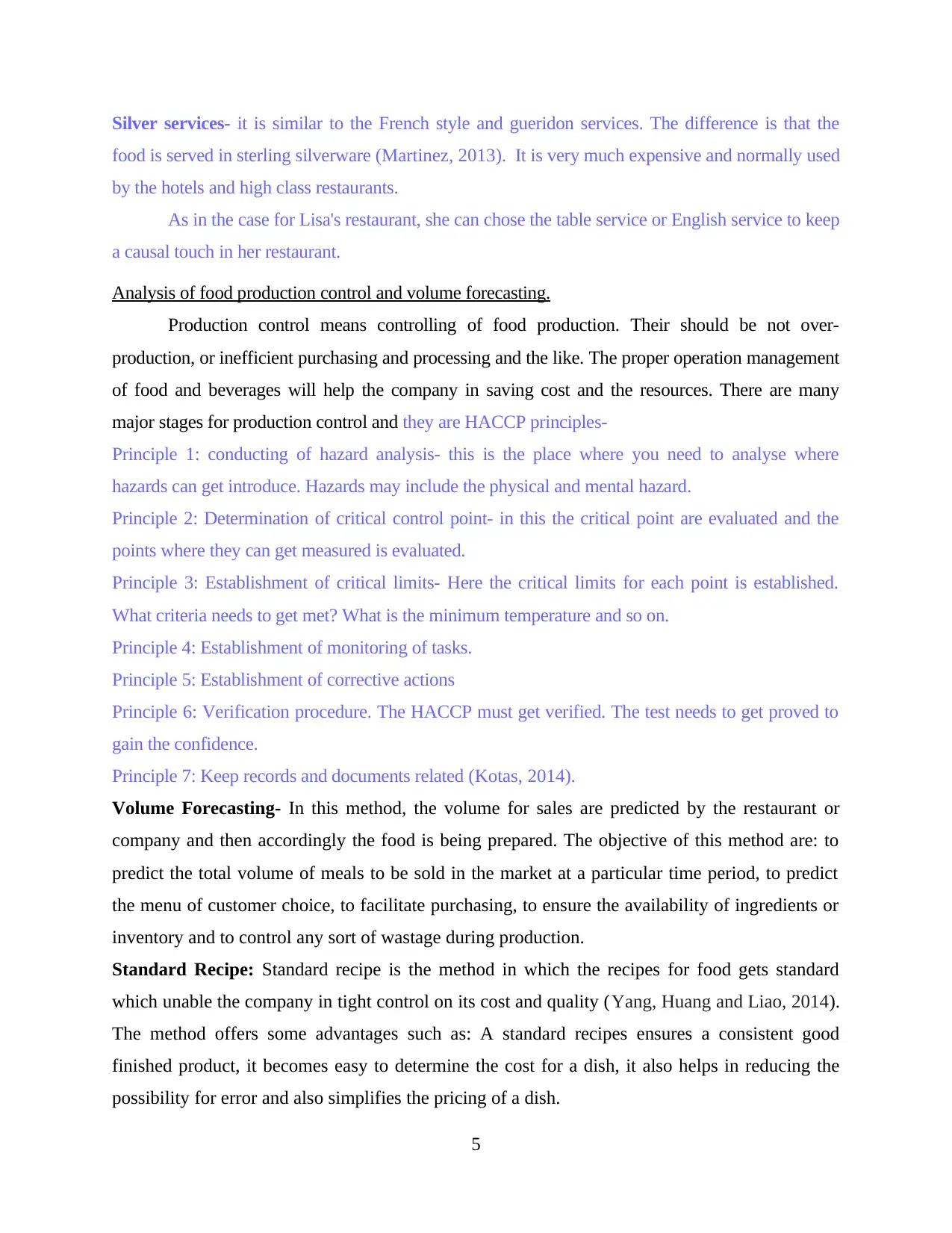
Silver services- it is similar to the French style and gueridon services. The difference is that the
food is served in sterling silverware (Martinez, 2013). It is very much expensive and normally used
by the hotels and high class restaurants.
As in the case for Lisa's restaurant, she can chose the table service or English service to keep
a causal touch in her restaurant.
Analysis of food production control and volume forecasting.
Production control means controlling of food production. Their should be not over-
production, or inefficient purchasing and processing and the like. The proper operation management
of food and beverages will help the company in saving cost and the resources. There are many
major stages for production control and they are HACCP principles-
Principle 1: conducting of hazard analysis- this is the place where you need to analyse where
hazards can get introduce. Hazards may include the physical and mental hazard.
Principle 2: Determination of critical control point- in this the critical point are evaluated and the
points where they can get measured is evaluated.
Principle 3: Establishment of critical limits- Here the critical limits for each point is established.
What criteria needs to get met? What is the minimum temperature and so on.
Principle 4: Establishment of monitoring of tasks.
Principle 5: Establishment of corrective actions
Principle 6: Verification procedure. The HACCP must get verified. The test needs to get proved to
gain the confidence.
Principle 7: Keep records and documents related (Kotas, 2014).
Volume Forecasting- In this method, the volume for sales are predicted by the restaurant or
company and then accordingly the food is being prepared. The objective of this method are: to
predict the total volume of meals to be sold in the market at a particular time period, to predict
the menu of customer choice, to facilitate purchasing, to ensure the availability of ingredients or
inventory and to control any sort of wastage during production.
Standard Recipe: Standard recipe is the method in which the recipes for food gets standard
which unable the company in tight control on its cost and quality (Yang, Huang and Liao, 2014).
The method offers some advantages such as: A standard recipes ensures a consistent good
finished product, it becomes easy to determine the cost for a dish, it also helps in reducing the
possibility for error and also simplifies the pricing of a dish.
5
food is served in sterling silverware (Martinez, 2013). It is very much expensive and normally used
by the hotels and high class restaurants.
As in the case for Lisa's restaurant, she can chose the table service or English service to keep
a causal touch in her restaurant.
Analysis of food production control and volume forecasting.
Production control means controlling of food production. Their should be not over-
production, or inefficient purchasing and processing and the like. The proper operation management
of food and beverages will help the company in saving cost and the resources. There are many
major stages for production control and they are HACCP principles-
Principle 1: conducting of hazard analysis- this is the place where you need to analyse where
hazards can get introduce. Hazards may include the physical and mental hazard.
Principle 2: Determination of critical control point- in this the critical point are evaluated and the
points where they can get measured is evaluated.
Principle 3: Establishment of critical limits- Here the critical limits for each point is established.
What criteria needs to get met? What is the minimum temperature and so on.
Principle 4: Establishment of monitoring of tasks.
Principle 5: Establishment of corrective actions
Principle 6: Verification procedure. The HACCP must get verified. The test needs to get proved to
gain the confidence.
Principle 7: Keep records and documents related (Kotas, 2014).
Volume Forecasting- In this method, the volume for sales are predicted by the restaurant or
company and then accordingly the food is being prepared. The objective of this method are: to
predict the total volume of meals to be sold in the market at a particular time period, to predict
the menu of customer choice, to facilitate purchasing, to ensure the availability of ingredients or
inventory and to control any sort of wastage during production.
Standard Recipe: Standard recipe is the method in which the recipes for food gets standard
which unable the company in tight control on its cost and quality (Yang, Huang and Liao, 2014).
The method offers some advantages such as: A standard recipes ensures a consistent good
finished product, it becomes easy to determine the cost for a dish, it also helps in reducing the
possibility for error and also simplifies the pricing of a dish.
5
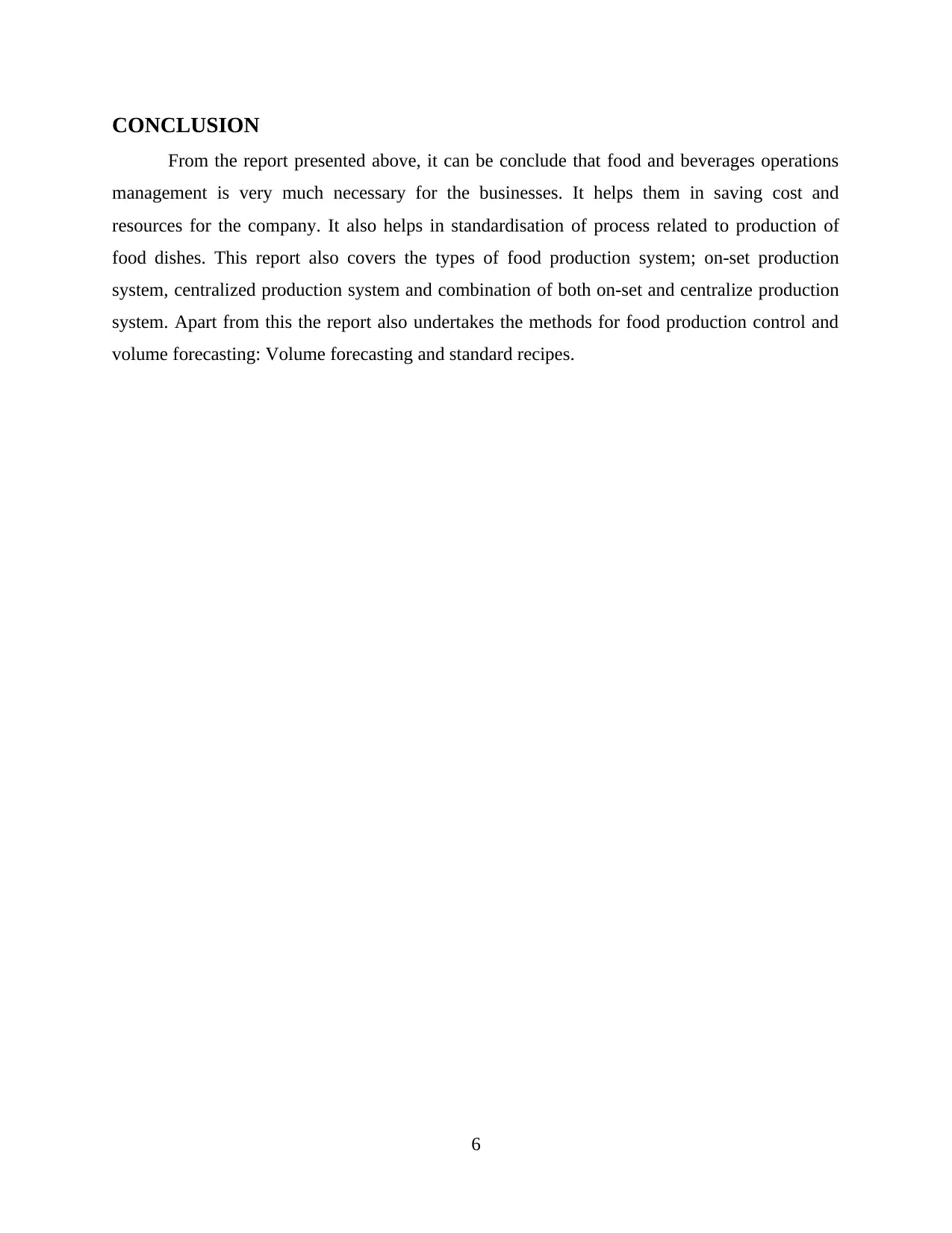
CONCLUSION
From the report presented above, it can be conclude that food and beverages operations
management is very much necessary for the businesses. It helps them in saving cost and
resources for the company. It also helps in standardisation of process related to production of
food dishes. This report also covers the types of food production system; on-set production
system, centralized production system and combination of both on-set and centralize production
system. Apart from this the report also undertakes the methods for food production control and
volume forecasting: Volume forecasting and standard recipes.
6
From the report presented above, it can be conclude that food and beverages operations
management is very much necessary for the businesses. It helps them in saving cost and
resources for the company. It also helps in standardisation of process related to production of
food dishes. This report also covers the types of food production system; on-set production
system, centralized production system and combination of both on-set and centralize production
system. Apart from this the report also undertakes the methods for food production control and
volume forecasting: Volume forecasting and standard recipes.
6
⊘ This is a preview!⊘
Do you want full access?
Subscribe today to unlock all pages.

Trusted by 1+ million students worldwide
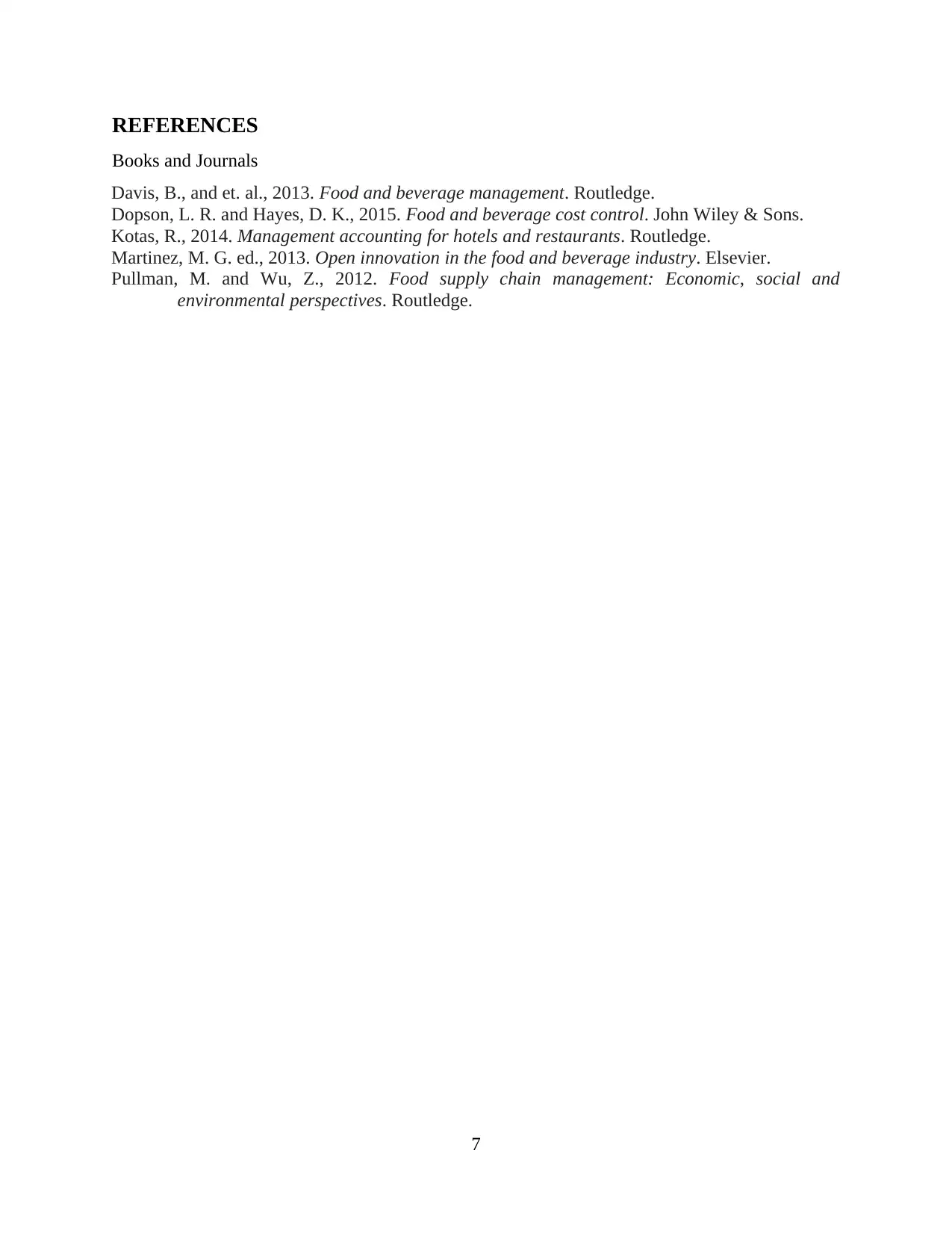
REFERENCES
Books and Journals
Davis, B., and et. al., 2013. Food and beverage management. Routledge.
Dopson, L. R. and Hayes, D. K., 2015. Food and beverage cost control. John Wiley & Sons.
Kotas, R., 2014. Management accounting for hotels and restaurants. Routledge.
Martinez, M. G. ed., 2013. Open innovation in the food and beverage industry. Elsevier.
Pullman, M. and Wu, Z., 2012. Food supply chain management: Economic, social and
environmental perspectives. Routledge.
7
Books and Journals
Davis, B., and et. al., 2013. Food and beverage management. Routledge.
Dopson, L. R. and Hayes, D. K., 2015. Food and beverage cost control. John Wiley & Sons.
Kotas, R., 2014. Management accounting for hotels and restaurants. Routledge.
Martinez, M. G. ed., 2013. Open innovation in the food and beverage industry. Elsevier.
Pullman, M. and Wu, Z., 2012. Food supply chain management: Economic, social and
environmental perspectives. Routledge.
7
1 out of 7
Related Documents
Your All-in-One AI-Powered Toolkit for Academic Success.
+13062052269
info@desklib.com
Available 24*7 on WhatsApp / Email
![[object Object]](/_next/static/media/star-bottom.7253800d.svg)
Unlock your academic potential
Copyright © 2020–2025 A2Z Services. All Rights Reserved. Developed and managed by ZUCOL.





